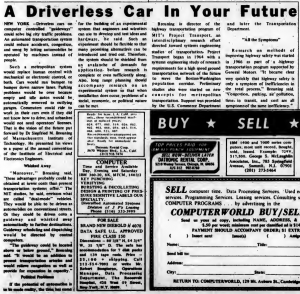April 3, 1968: Early visions for self-driving cars relied on computerized roadways
While today’s efforts to create a driverless future focus on artificially intelligent cars, an early attempt instead focused on computer-controlled roads.

With each advance in autonomous vehicle technology, commonly known as self-driving cars, the future of mobility looks increasingly driverless. While many vehicles today are augmented with artificial intelligence to include self-driving features like automatic steering, acceleration, and braking, fully autonomous vehicles are still out of reach.
The earliest documented instance of research into autonomous vehicles is from 1925, when a company called Houdina Radio Control drove a radio-controlled driverless car through New York City traffic. Since then, advances in computing and artificial intelligence have caused approaches for developing autonomous vehicles to evolve dramatically.
In 1968, Computerworld magazine featured “Project Transport,” an interdisciplinary research initiative led by Dr. Siegfried Breuning at the Massachusetts Institute of Technology. Dr. Breuning described his vision of driverless cars, wherein cars would “run bumper to bumper” along computer-controlled guideways.
The fundamental difference between Dr. Breuning’s approach and modern approaches can be seen in where the computer control lies. Research into driverless cars focused on modifying the road – through guideways, cables, etc. – until the 1980s when the first driverless car controlled via computer vision emerged. Today, nearly all work on driverless cars focuses on the car and AI, as opposed to any road modifications.
Even with this fundamental difference, similarities existed between Dr. Breuning’s vision and modern self-driving systems. He imagined that cars would both “be able to be driven as automobiles on conventional streets” and “be driven onto a guideway and whisked away automatically to further destinations.” This is similar to how most self-driving cars are designed today, with both conventional driving features in addition to autonomous features. Dr. Breuning predicted that there would be a need to plan ahead for social, economic, or political impacts of autonomous vehicles. In recent years, several nations have passed their first legislation on autonomous driving features, and much more legislation is likely to emerge as the technology becomes more mainstream.
–By Kathleen Esfahany